Gary Neal Hansen's Blog, page 31
July 25, 2018
Saints You’ve Probably Never Heard of: Greatmartyr Marina

 St. Marina with scenes from her life, around 1754 (public domain)
St. Marina with scenes from her life, around 1754 (public domain)Last week I made up a title for a post (a riff on a made up Jeopardy category) and a couple of readers said they were looking forward to more in the series.
Series? What series?
Well here we go then.
Saints You’ve Never Heard of for 200, Alex
“Greatmartyr Marina” came up in the hymns of the Orthodox Matins service on July 17. Intrigued, I did some research of the kind one can do when one is parenting solo while one’s wife is across an ocean at a conference.
That is to say, I checked some websites.
Marina is not someone I’d ever heard of.
Okay, I’d heard her name: she is one of a long list of saints who are named in a particular prayer at Matins pretty much every day, at least in the Greek church. (The same prayer apparently includes a somewhat different list of names in the OCA and the Antiochian churches, and I didn’t look to see whether she comes up in all versions.)
The OCA has a really great website for checking out Orthodox saints. You plug in a date, and up pops a list of maybe six or a dozen people who are remembered on that day each year, usually with an icon for each. Click one and you get a distillation of her or his life story. (No links to scholarly sources or translations of early hagiographies, alas, but it’s a great place to start.)
There are similar resources for Catholic saints. I checked a couple for their take on Marina.
Turns out Marina is venerated in the Coptic church too. A church that is named after her had a chatty version of her life, with bits of homiletical encouragement woven in.
So everybody loves her. If they know her, that is.
But unlike with your more famous saints, I was not having much luck finding an accessible English translation of the primary sources on her life from the comfort of my living room.
I gathered that she is one of the saints whose life contains some eyewitness material, so I was keen to find it.
Keen in the way one can be while doing research between kid crises.
Anyway, what was fascinating to me was the the way Eastern Orthodox, Oriental Orthodox, and Roman Catholic versions of her life converged and diverged on the details.
Here’s the gist:
Marina (sometimes known as Margaret) was born late third century — she was fifteen when the emperor Diocletian was persecuting the Church (284-305).
She lost her mother very early in her life. (In some versions she lost her father too, but in others her father was a pagan priest.)
Her father (or whoever was in charge) sent her to be raised by a nanny, who turned out to be a devout Christian.
Young Marina came to faith in Christ, but she had apparently not been baptized.
She got called before the governor who was smitten with her, and asked her to marry him, on condition that she worship his pagan gods.
She refused, having decided already to not marry, but to devote herself to Christ alone.
His affection quickly turned to the most violent abuse, and he had her tortured. The torture was so gross that even the governor who ordered it couldn’t watch.
The implements of torture included a trident, presumably by association with her name, which has the connotation of the sea.
She was also burned in a way you might think would kill her.
In some versions, I think more in Western versions, she is set upon by a dragon and defeats it. It swallowed her, but either the cross she carried or the saint herself upset his tummy and he threw her up.
(The dragon sounds to me like the symbolic embodiment of the tyrannical evil of the governor, combined with an allusion to the Jonah story, but it became a core story element. It seems to be a common feature of her artistic portrayals, along with images of her beating a demon with a big hammer.)
But, in a way familiar to readers of early saints’ lives, she kept getting miraculously healed after each round of attempted murder/martyrdom.
She prayed that God would let her be baptized before her death. The governor overheard the reference to water and decided to drown her.
(One version says he planned to drown her in boiling lead. This, like the dragon, was surely an emotive embellishment on the story. Either way, I’m thinking her decision not to marry this guy was quite sound.)
She survived. A voice from heaven affirmed that this would count as her baptism.
Finally fed up, the governor had her beheaded, possibly with 15,000 others, some of whom had converted to Christ by seeing her faithfulness in suffering.
In one account, the executioner himself was converted by Marina’s testimony, so after removing her head, he cut off his own — entering into the ranks of the martyrs, according by this telling, though it seems surprising in light of Orthodox views on suicide.
The Coptics have her relics in a church in Cairo, though one of her hands is said to be in a monastery on Mt. Athos — though I’m sure I also ran across a reference to her hand being somewhere further West in Europe. Maybe that’s her other one.
Greatmartyr Marina
I’m still hoping to dig up the source material some day. (If you, gentle reader, know of an online source do let me know.) Her story is pretty shifty-drifty between the various accounts, and I’d like to see how it was portrayed in its earliest version.
But even without that bit of actual research and analysis, Marina is a hero worth contemplating in the 21st century. She’s a great example of the many women of the Early Church who held so closely to Christ that they were able to stand up to oppressive male power figures.
You can ponder whether choosing the life of a consecrated virgin, an early nun, had the potential to give her social mobility and a new kind of power. When a woman’s survival depended on having a male partner, stepping outside of traditional marriage would be a kind of freedom — and scary, and risky.
In any case, in this era of the “me too” movement, a woman who had the courage to decline the advances of a governor is impressive. And costly: her “suitor” could flip the switch from amorous advances to torture and murder.
But the thing to note is that this was courage that came through faith, and a desire to live a new life in Christ that brooked no compromise with the values of secular culture. She wasn’t going to worship what her culture loved or marry someone in power just to get along. She wanted Jesus instead.
In Christ, for Christ, Marina lived in freedom.
And her freedom in Christ, for Christ, included suffering and death.
++++++++++++
I’d love to send every new post on these role models of discipleship — along with my other new articles and announcements. Just scroll down to the black box with the orange button to subscribe to my weekly(ish) newsletters and I’ll send them to your inbox.
The post Saints You’ve Probably Never Heard of: Greatmartyr Marina appeared first on Gary Neal Hansen.
July 24, 2018
Monday Meditation: RCL Year B, 17th Sunday in Ordinary Time, John 6:1-21

 Amedee Varint, Christ marchant sur la mer (public domain)
Amedee Varint, Christ marchant sur la mer (public domain)This Sunday we are back in John. The Lectionary gives us John’s version (John 6:1-21) of the bits of Mark they edited out last week (Mark 6:35-52).
John 6:1-21
The same basic material is here:
Jesus & Co. have sailed across the sea.
People on land rushed to where Jesus was going and got there first.
Jesus fed the 5000 guests with five loaves and two fish.
The disciples sailed off while Jesus stayed back alone.
When the disciples were tossed by a storm Jesus walked across the sea to help them — which, as you might expect, freaked them out.
John’s version is peppered with tiny difference in the details. Some of these ring the melody notes of John’s Gospel, and others are just intriguing.
The reason the crowd came was “they saw the signs” Jesus was doing.
It all happened when “the Passover, the festival of the Jews, was near.”
Jesus himself sets up the feeding miracle, asking Philip where to get bread for the crowd.
After the meal, when they fill twelve baskets of leftovers, it is because Jesus says, cryptically, he wants nothing to be wasted.
When Jesus withdraws alone it is not to pray but because he knows the crowd will otherwise make him king.
When Jesus comes, walking on the water, the miracle does not happen when Jesus comes into the boat, but because “Then they wanted to take him into the boat…”
And the miracle itself is not that the storm was stilled, but that they suddenly found themselves on the other side: “…and immediately the boat reached the land towards which they were going.”
My attention, though, goes to Jesus’ words to the floundering sailors as he walks toward them on the sea.
In the NRSV it has a sort of Shakespearean pomposity:
It is I; do not be afraid.” (John 6:20, NRSV)
Whatever translation you use, it probably sounds much the same. But those first word are key, and they are weighty. They need a more literal translation. Here they are in Greek:
Ἐγώ εἰμι,
says Jesus. That’s
I am.
If you’ve spent much time in John’s Gospel you’ve probably heard about the “I am” sayings that are sprinkled through it. They point to how John is different from Matthew, Mark, and Luke, called the “synoptic” Gospels because they all take a similar viewpoint.
In the “Synoptic Gospels” Jesus teaches about the Kingdom of heaven.
In John, Jesus teaches about Jesus — he mentions the Kingdom only three times.
Instead of talking about the kingdom of heaven or the kingdom of God, in John Jesus says “I am” a lot. Like two dozen times.
By contrast each of the Synoptics use the phrase five or fewer times — and they are not all about Jesus.
Of course when John uses the phrase, Jesus is not always saying “I am the XYZ.” But in almost every case, Jesus is saying something very significant about himself:
I am the good shepherd,
I am the light of the world,
I am the bread of life,
I am the true vine,
… you remember.
And you get the significance of it all when you hear Jesus saying
Before Abraham was, I AM.” (John 8:58)
That is intended to remind you of the scene of the burning bush in Exodus where Moses asked God for his name. You got it:
I Am.
So Jesus, throughout the Gospel of John, is trying to get across the point across he emphasized in John 8:58. We are supposed to see that Jesus is the living and eternal God, who has come in the flesh.
All that is pretty explicit. It is John’s exposition of his opening assertion that
In the beginning was the Word … and the Word was God. … And the Word became flesh and lived among us, and we have seen his glory…” (John 1:1-14)
So look at the scene again.
The disciples go off in a boat.
A storm comes up on the sea — but Jesus is not there.
Jesus comes walking toward them on the sea — totally freaky. What is he doing there? He can’t be walking on the water. No way!
But Jesus calls out
I Am.
Don’t be afraid my friends. You thought I was just a guy like you. I am like you — but also,
I Am.
He’s telling them, first in his action by walking on the water, then clear as a bell in his words, that he is God in the flesh.
That’s why he can say next,
Don’t be afraid.
Don’t be afraid when the wind whips up the waves, because the one who is with you is God in the flesh.
Don’t be afraid even though you are sailing over the depths that could swallow you up and drown you, because the one who is with you is God in the flesh.
And take this big scene as a symbol, a metaphor, because you and I are sailing over some deep water right now, with some waves that look a lot higher than our little boats. Jesus is standing on those waters. Jesus says
I am. Don’t be afraid.
This is the second of what I think of as John’s “secret” ‘I am’ sayings. There are others. Most English translations hide them. John’s Greek shows that we are intended to see them.
Interestingly enough, this is the one “I am” saying that both Matthew and Mark share with John. In all three Gospels, Jesus says to them from the surface of the sea
I am. Don’t be afraid.” (John 6:20, Matthew 14:27, Mark 6:50)
God seems to want us to get the point.
And especially since John spends his whole Gospel hammering the issue, we should consider whether these two simple words are a summary of the good news in stormy times.
++++++++++++
My “Monday Meditations” are my own exploration of the Gospel assigned for the coming week in the Revised Common Lectionary. I’d love to send them (along with my other new articles and announcements) straight to your inbox. Just scroll down to the black box with the orange button and subscribe to my weekly(ish) newsletter.
The post Monday Meditation: RCL Year B, 17th Sunday in Ordinary Time, John 6:1-21 appeared first on Gary Neal Hansen.
Monday Meditation: RCL Year B, 17th Sunday in Ordinary Time, John John 6:1-21

 Amedee Varint, Christ marchant sur la mer (public domain)
Amedee Varint, Christ marchant sur la mer (public domain)This Sunday we are back in John. The Lectionary gives us John’s version (John 6:1-21) of the bits of Mark they edited out last week (Mark 6:35-52).
John 6:1-21
The same basic material is here:
Jesus & Co. have sailed across the sea.
People on land rushed to where Jesus was going and got there first.
Jesus fed the 5000 guests with five loaves and two fish.
The disciples sailed off while Jesus stayed back alone.
When the disciples were tossed by a storm Jesus walked across the sea to help them — which, as you might expect, freaked them out.
John’s version is peppered with tiny difference in the details. Some of these ring the melody notes of John’s Gospel, and others are just intriguing.
The reason the crowd came was “they saw the signs” Jesus was doing.
It all happened when “the Passover, the festival of the Jews, was near.”
Jesus himself sets up the feeding miracle, asking Philip where to get bread for the crowd.
After the meal, when they fill twelve baskets of leftovers, it is because Jesus says, cryptically, he wants nothing to be wasted.
When Jesus withdraws alone it is not to pray but because he knows the crowd will otherwise make him king.
When Jesus comes, walking on the water, the miracle does not happen when Jesus comes into the boat, but because “Then they wanted to take him into the boat…”
And the miracle itself is not that the storm was stilled, but that they suddenly found themselves on the other side: “…and immediately the boat reached the land towards which they were going.”
My attention, though, goes to Jesus’ words to the floundering sailors as he walks toward them on the sea.
In the NRSV it has a sort of Shakespearean pomposity:
It is I; do not be afraid.” (John 6:20, NRSV)
Whatever translation you use, it probably sounds much the same. But those first word are key, and they are weighty. They need a more literal translation. Here they are in Greek:
Ἐγώ εἰμι,
says Jesus. That’s
I am.
If you’ve spent much time in John’s Gospel you’ve probably heard about the “I am” sayings that are sprinkled through it. They point to how John is different from Matthew, Mark, and Luke, called the “synoptic” Gospels because they all take a similar viewpoint.
In the “Synoptic Gospels” Jesus teaches about the Kingdom of heaven.
In John, Jesus teaches about Jesus — he mentions the Kingdom only three times.
Instead of talking about the kingdom of heaven or the kingdom of God, in John Jesus says “I am” a lot. Like two dozen times.
By contrast each of the Synoptics use the phrase five or fewer times — and they are not all about Jesus.
Of course when John uses the phrase, Jesus is not always saying “I am the XYZ.” But in almost every case, Jesus is saying something very significant about himself:
I am the good shepherd,
I am the light of the world,
I am the bread of life,
I am the true vine,
… you remember.
And you get the significance of it all when you hear Jesus saying
Before Abraham was, I AM.” (John 8:58)
That is intended to remind you of the scene of the burning bush in Exodus where Moses asked God for his name. You got it:
I Am.
So Jesus, throughout the Gospel of John, is trying to get across the point across he emphasized in John 8:58. We are supposed to see that Jesus is the living and eternal God, who has come in the flesh.
All that is pretty explicit. It is John’s exposition of his opening assertion that
In the beginning was the Word … and the Word was God. … And the Word became flesh and lived among us, and we have seen his glory…” (John 1:1-14)
So look at the scene again.
The disciples go off in a boat.
A storm comes up on the sea — but Jesus is not there.
Jesus comes walking toward them on the sea — totally freaky. What is he doing there? He can’t be walking on the water. No way!
But Jesus calls out
I Am.
Don’t be afraid my friends. You thought I was just a guy like you. I am like you — but also,
I Am.
He’s telling them, first in his action by walking on the water, then clear as a bell in his words, that he is God in the flesh.
That’s why he can say next,
Don’t be afraid.
Don’t be afraid when the wind whips up the waves, because the one who is with you is God in the flesh.
Don’t be afraid even though you are sailing over the depths that could swallow you up and drown you, because the one who is with you is God in the flesh.
And take this big scene as a symbol, a metaphor, because you and I are sailing over some deep water right now, with some waves that look a lot higher than our little boats. Jesus is standing on those waters. Jesus says
I am. Don’t be afraid.
This is the second of what I think of as John’s “secret” ‘I am’ sayings. There are others. Most English translations hide them. John’s Greek shows that we are intended to see them.
Interestingly enough, this is the one “I am” saying that both Matthew and Mark share with John. In all three Gospels, Jesus says to them from the surface of the sea
I am. Don’t be afraid.” (John 6:20, Matthew 14:27, Mark 6:50)
God seems to want us to get the point.
And especially since John spends his whole Gospel hammering the issue, we should consider whether these two simple words are a summary of the good news in stormy times.
++++++++++++
My “Monday Meditations” are my own exploration of the Gospel assigned for the coming week in the Revised Common Lectionary. I’d love to send them (along with my other new articles and announcements) straight to your inbox. Just scroll down to the black box with the orange button and subscribe to my weekly(ish) newsletter.
The post Monday Meditation: RCL Year B, 17th Sunday in Ordinary Time, John John 6:1-21 appeared first on Gary Neal Hansen.
July 19, 2018
Letters to a Young Pastor: The Children’s Sermon — Is it Yours?

 CC by wiredforlego-SA 2.0
CC by wiredforlego-SA 2.0Dear ______:
My goodness, with the kids being out of school for summer the time gets swept away. Sorry to have not written for so long.
You are kind to ask if there are other criteria for making sure your children’s sermon is on track. I mentioned checking what you prepare to make sure it is theologically true, both in its assertions about the Bible and its assumptions about the gospel.
I only have a little time to write today before the kids are up, so I’ll tell you a story to illustrate another crucial question to ask about your children’s sermon: “Is it yours?”
Is It Yours?
True story:
I was in a worship service. The young preacher gave a children’s sermon that was primarily a story about her son. There was a set up that connected somehow to her biblical text. Then came the story, in which her little boy made an incredibly witty comment that brought her point home. We all laughed.
The very next Sunday I happened to be traveling. I attended another worship service, more than three hundred miles away. The much older preacher gave a children’s sermon. In this case the focus was on his son. There was a set up that connected to his biblical text. Then came the story, in which his little boy made this incredibly witty comment that brought his point home. Everybody laughed.
Well, not me, actually.
These two preachers told the exact same story, with the exact same gag line from the lips of the preacher’s own son.
Coincidence? I don’t think so.
I had no idea that they even knew each other. But apparently they had produced a child.
And a witty child to boot.
I kept their secret from the relevant spouses.
Don’t buy your sermons. Find them for yourself.
This, my friend, is one peril of preaching someone else’s sermon, whether you read it in a book or bought it on the internet. Someone might find you out.
Of course you probably won’t be found out. Will that make it okay?
Another risk is weightier: If you present it as your own, you are lying. You are using the Christian pulpit to intentionally lie.
This is a problem for followers of a guy who called himself “The Truth.”
If it were a paper in seminary you’d be failed for plagiarism.
More subtle but perhaps more important, if you preach someone else’s sermon you miss the opportunity to communicate the message of the gospel in a manner that is true to the gospel.
The biblical message is personal. You see in the Gospels that God came in person to deliver it. Churches have, ever since, called their pastors to deliver the message in person on Sunday morning — just as all the members are called to speak as true witnesses to Christ in their real relationships outside the Sunday service.
Don’t buy a sermon, or steal one from a book or website. Find one for yourself.
You will find it by digging in the biblical text and, in a different way, digging into the lives of the people of your congregation — old ones or young ones.
Once you find your own children’s sermon, speak it to them personally. Using a pre-fab children’s sermon means abdicating your responsibility to minister to children.
Have fun out there,
Gary
P.S. A colleague once told me about a very famous preacher who had published multiple books of sermons. In his travels he would, more often than you might guess, visit churches where preachers regaled him with a sermon that he himself had written. The source of the sermon was never acknowledged from the pulpit of course. Afterward, in the little line up at the door where he would shake hands with the pastor, introduce himself with a smile, and say, “I was blessed.”
P.P.S. Of course you should spend time reading sermons by other preachers, especially ones you greatly respect. That is how you, the preacher, can find a way to hear the Word of God in a sermon, when so many will be coming from your own mouth. Also it’s like an amateur golfer watching the U.S. Open. You can learn a lot from watching someone with greater skill.
++++++++++++
These “Letters to a Young Pastor” are an ongoing Thursday series. I’d love to send each one to you, along with my other new articles and announcements. Scroll down to the black box with the orange button and sign up for my weekly(ish) newsletter and you’ll never miss an entry.
The post Letters to a Young Pastor: The Children’s Sermon — Is it Yours? appeared first on Gary Neal Hansen.
July 18, 2018
Monday Meditation: RCL Year B, 16th Sunday in Ordinary Time, Mark 6:30-34, 53-56
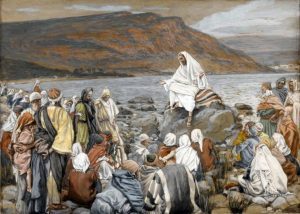
 Jesus Teaches the People by the Sea, JamesTissot (public domain)
Jesus Teaches the People by the Sea, JamesTissot (public domain)The Revised Common Lectionary has given us a pair of texts this Sunday (Mark 6:30-34, 53-56). They are shoved together so they appear to be one story, but actually they are separated by a whole eventful day.
Mark 6:30-34, 53-56
Story 1: The disciples return from their mission trip and Jesus takes them away for a rest, only to be found out by an enormous crowd in need of teaching.
Omitted:
That afternoon he gave a miraculous meal to the crowd of 5000.
In the evening he sent the disciples ahead by boat while he stayed alone to pray.
Early in the morning he decided to walk across, apparently planning to surprise them by being at their destination first.
There was a storm and he stopped to help — totally freaking them out, I might add.
Story 2: The next day when they came to land at Gennesaret, word spread like wildfire, and people came in droves bringing all their sick friends for healing.
Themes
There are a number of things going on in this text that are worthy of meditation, and all are themes echoed in other passages in Mark’s Gospel.
1. The goodness of the good news in action
Jesus doesn’t only speak good news. He offers real life, real healing, real restoration, giving it all away wherever he goes. The result is he is enormously popular. People totally want this stuff.
Wherever he goes, his reputation precedes him. When he takes the returning missionaries off for a rest, a crowd has already gathered. When they sail off to Gennesaret, word spreads like wildfire.
People come to Jesus from everywhere. They bring their friends.
And this is humbling for all of us who are parts of churches which people aren’t rushing to — and churches whose members think twice before inviting a friend to come and visit.
By the painful logic of Mark’s Gospel, if we were doing ministry his way people would be beating down our doors.
2. Commitment to (inconvenient) mission
In this section of Mark I’ve long been impressed by Jesus’ quietly relentless focus on his own priorities. He knows what his mission is, and he knows what kinds of things embody it or make it possible.
At a glance, Jesus is sort of buffeted about by external pressures, especially by those crowds that keep showing up.
But look at what he does. When the disciples return from their mission, he sees and tends to their need for rest. When that agenda is interrupted by an unexpected crowd, Jesus turns his attention to their need — they are a bunch of lost sheep, and need his teaching. In the omitted bits there is more, as he tends to their physical hunger.
All of this looks like interruption and distraction. But Jesus is always conscious of his purposes: to build up, to teach, to heal, to feed.
I know I get deeply frustrated by days when my sense of priorities gets thwarted by surprising demands. Maybe it bugged Jesus too. If so, Mark didn’t report it. What I see is Jesus redirecting his energy where it was needed to fulfill a different part of his mission.
The management consultants surely don’t like this, since he seems to let the urgent prevail over the important. But is he? It is actually all right in line with his mission — just in different ways than he first aimed for.
3. The deep
Then there is the Sea of Galilee. Scene by scene, they sail across and face the next scene of action on land, whether it is healing or teaching or whatever.
In between outward activities, Jesus and his friends spend time sailing in the deep.
It is very metaphorical. It gets amplified or clarified in one of the omitted bits, where Jesus himself goes off to pray while his friends sail across. That’s the real deep.
We need to find restoration, to grow in our communion with Christ in a life of active ministry. To do that we need to spend time sailing in the deep, or going alone up the mountain. Life needs a rhythm of work and rest, of active service and contemplation — hey, kind of like that seven day cycle thing with the Sabbath and all.
4. Relics
Last I would note in passing the seemingly odd thing that happened at Gennesaret. The sick people didn’t need or ask for a conversation with Jesus. They just needed to be positioned to reach out and touch his garment as he passed, and they were healed.
This happened before: Remember the woman who had a bleeding disorder for 12 years before sneaking up in a crowd to touch Jesus’ clothes?
This will happen again: Think about the stories in Acts where people were healed by Peter’s shadow falling across them (Acts 5:15-16), or by touching a handkerchief that had touched Paul’s body (Acts 19:12).
I ask you: Is it any wonder that in the early centuries the bones of the martyrs were treasured as relics? Protestants tend to think it odd or superstitious when Catholic or Orthodox Christians value relics of saints, including bits of their clothing. They would have good reason to tell us they are just being biblical.
++++++++++++
I’d love to send you all of these “Monday” Meditations, along with my other new articles and announcements. Scroll down to the black box with the orange button and subscribe to my weekly(ish) newsletter and all this will be yours…
The post Monday Meditation: RCL Year B, 16th Sunday in Ordinary Time, Mark 6:30-34, 53-56 appeared first on Gary Neal Hansen.
July 11, 2018
Saints You’ve Probably Never Heard of: Greatmartyr Euphemia
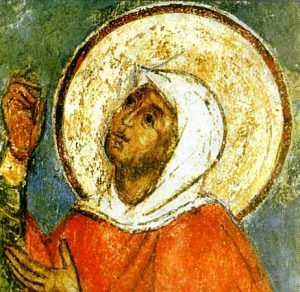 St Euphemia (public domain)
St Euphemia (public domain)Occasionally my blog feels like background work for a round of Jeopardy.
I’ll take ‘Saints you’ve never heard of’ for 100, Alex.
Today is one of those days.
Mr. Trebek says,
And the answer is — She was a consecrated virgin, a holy martyr, and a theologian who influenced the doctrinal decision at one of the great Ecumenical Councils.
Before I spill the beans, here’s the back story.
Morning prayer took me into the Orthodox service of Matins (on the amazing Digital Chant Stand app, produced by Fr. Seraphim Dedes).
Matins and Vespers always include some hymns that remind worshippers of whichever saint or saints are being commemorated that day. So my prayerful meditations had me time and again praising God for the wonders of “Greatmartyr Euphemia.”
Who is ‘Greatmartyr Euphemia’?
This blows Alex away.
That’s right!
I had, of course, never heard of her. Or if I had, I’d forgotten.
The historian in me listens to these hymns to see how much of the saint’s story I can piece together. It is easy work if I know the person from other sources.
Euphemia? Not so much.
I’ll spare you the trail of breadcrumbs.
Here’s what I learned in a quick bit of research:
She was a martyr in 304, in the great persecution under the Emperor Diocletian — which means she was gone long before the Councils, which started in 325.
But her body, every bone a holy relic, was preserved in the city of Chalcedon.
I’ll take ‘Great Cities in Church History’ for 451, Alex.
Alex looks at me quizzically. He didn’t expect the board to give me so many Church History categories.
And the answer is — This city in Asia Minor played host of the Fourth Ecumenical Council.
Awesome! I’ve put this on Intro Church History exams myself.
What is ‘Chalcedon’?
Alex is not surprised
Right again.
At Chalcedon, in the year 451, the representative bishops of the Christian world were debating the hot issue dividing the Church:
Christians had been clear since the Council of Nicaea in 325 that Jesus Christ is true God and true human.
But, as one Person, does he have one nature , as the so-called “Monophysites” said?
Or is he mysteriously one Person in two natures — one complete and true divine nature and one complete and true human nature?
You and I probably assume that weighty theological decisions like this were made by rational argument, biblical exegesis, or whatever.
If you had taken my Intro Church History class you’d still think so. You would have heard the famous story of the “tome” of Pope Leo being read and providing a knockout argument against the Monophysites.
The bishops were convinced by Leo’s careful analysis: Christ is one person in two natures, and those natures are not confused, changed, divided, or separated.
It seemed like the Apostle Peter, first bishop of the Church in Rome, was speaking through Leo, the heir to his office. Slam dunk. The Nestorians are out. The Chalcedonian view defines Orthodoxy.
Alex is ready to wrap the show.
For Final Jeopardy our category is ‘Versions of important stories that look totally different when read in hagiographic literature.’
Alex observes that this is a very unusual category.
I’m fine with that.
And the answer is — The resolution to the Monophysite Debate at Chalcedon.
I scribble on my card for the entire length of the Jeopardy song.
What is, ‘When the bishops couldn’t come to agreement, they took two creeds, one from the Monophysite camp and one from the “two natures” camp, and placed them in the crypt of Greatmartyr Euphemia, sealed the tomb and guarded it for three days while they fasted and prayed, then opened it to find the Monophysite creed tossed to her feet, and the “two natures” creed in her right hand — whereupon the long-dead woman reached out and handed the “two natures” creed to the bishops to show her approval’?
Alex is astounded.
The Monophysites were defeated. Many converted to the ‘two natures’ side (which is still the view of Eastern Orthodoxy, Roman Catholicism, and most Protestantism). The rest became what is known as the ‘Oriental Orthodox Churches.’
I’ll be back on the show tomorrow night.
++++++++++++
I’d love to send you all my posts on saints you know and saints you don’t, plus my other articles and announcements. Scroll down to the black box with the orange button to subscribe to my weekly(ish) newsletter and all this will be yours…
The post Saints You’ve Probably Never Heard of: Greatmartyr Euphemia appeared first on Gary Neal Hansen.
July 10, 2018
Monday Meditation: RCL Year B, 15th Sunday in Ordinary Time, Mark 6:14-29
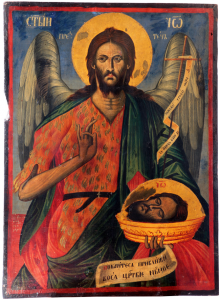 Nikola Mihaylov Kozi Dol Church St John the Baptist Icon (public domain)
Nikola Mihaylov Kozi Dol Church St John the Baptist Icon (public domain)This Sunday’s lectionary Gospel text is an odd one. Go read Mark 6:14-29 for yourself and let me know if you think so too.
I’ll wait.
Doo dee doo, dee dee dum …
Okay, you’re back. Why is it an odd text?
Here’s why I think it’s odd: Jesus doesn’t show up.
Mark 6:14-29
It is a long excursus about Herod and his troubles with John the Baptist.
Herod Antipas is plagued with well-earned guilt for murdering John to please his wife and daughter. Though I doubt the daughter was entirely pleased in the end.
Imagine the soldier coming to her door.
Knock knock.
Who is it?
Awkward pause.
Special Delivery: one severed human head on a platter.
No surprise she quickly passed it on to her mom.
Uh mom … I think you wanted this?
I count it as one of the grossest moments in Holy Scripture.
Three possible takeaways
There are all kinds of illustrative moments in the story, maybe even morals.
1. Herod has sinned, but doesn’t know how to deal with it — and that totally messes with his mind.
He is so burdened by what he has done that when he hears of another faith leader working miracles and teaching wisdom he jumps to the weirdest possible conclusion:
John, whom I beheaded, has been raised.” (Mark 6:16, NRSV)
Then all the courtiers said,
Of course, your majesty. That has to be it.” (No Translation Ever)
Moral of the story: When you sin big, make your confession and find forgiveness. The cover up will just lead you to say and do further crazy things.
2. Herod is prone to making rash promises — and that is not a good character trait.
His daughter dances at his birthday party and he rushes out and offers her any wish she might think of. She is welcome to ask for anything up to a full half of his realm.
That’s bad parenting. Just sayin’.
Don’t make open ended offers. Better:
Do you want broccoli or a salad, your choice.
You read the story. The offer didn’t end well.
3. Herod is too committed to pleasing those around him.
Having your mind set on being kind to those around you is an excellent thing.
Wanting to show love to people is great, whether they are your family, your courtiers if you have some, or the guests at your birthday party.
Love your neighbor is always a worthy guide.
But you miss the mark if you think you have to make these people happy. If you think you are obliged to please all these people, you are going to end up in a world of hurt.
You might know, for instance, that a certain prophet of God whom you have in your dungeon should be kept alive.
But if you want to please your daughter and your wife, you might end up pushed toward murder — at least if you are Herod Antipas.
And if you made a rash promise (see #2 above) in front of your courtiers and other minions and guests at your birthday party, you might feel you need to follow through in order to please them too, or to not be ashamed in front of them.
Moral of the story: Set out to love God and your neighbor, but don’t think that you can please all, or most, or really any of the people all the time.
John the Baptist, and His Head(s) in Christian Art
What I find interesting about this story, though, is the way it played out in the later history of the church. John was a major player in the story of Jesus, and Christians have traditionally made a very big deal about him.
He is not just the cousin who baptized Jesus. John is “the forerunner,” the last of the Old Testament prophets, a hinge figure in salvation history. You find him in the commemorations of the Church year East and West, and in Christian art.
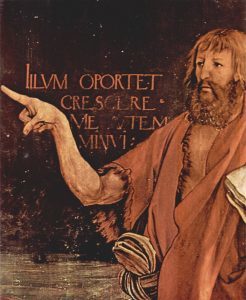 Matthias Grunewald, Isenheim altarpiece (detail; public domain)
Matthias Grunewald, Isenheim altarpiece (detail; public domain)Karl Barth particularly liked John in the Grünewald alter piece, with his long and bony finger pointing to Christ on the cross. He wasn’t there, of course. Grunewald brought him back from the grave and reattached his head for the picture.
What I personally enjoy, though, are some of the Orthodox icons of John the Baptist. Often he’s pictured, not only with the wings of an angelic messenger, but with two heads. One sits on his shoulders, where you expect it. A second lies on a platter, as delivered to Herod’s daughter.
Sometimes the head on the platter is at his feet. Sometimes he holds it in his own arms.
I always expect him to look down at his head in surprise, but he steadfastly faces forward. Actually sometimes he sort of seems to roll his eyes at the situation.
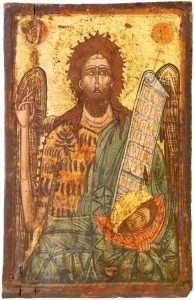 St John the Baptist Late XVII – Early XVIII Cenury St Mary Blonichka Church, Ohris Icon Gallery (public domain)
St John the Baptist Late XVII – Early XVIII Cenury St Mary Blonichka Church, Ohris Icon Gallery (public domain)But the early Christians (as Catholic and Orthodox Christians are still) were very keen on holy relics. Mark tells us John’s body was buried — but where was his head? Well, it was lost for a very long time, buried on Herod’s property by the wife of his steward.
The discovery of the head of John the Baptist was a notable day, and is celebrated still every year.
But then, since the head got lost again, the Orthodox calendar also includes a celebration of the second finding of the head of John the Baptist.
And if losing it once were not enough, the Church also celebrates the third finding of the head of John the Baptist.
I suppose since the saint had a hard time keeping a firm grip on his own head we shouldn’t be surprise that the Church has done no better.
++++++++++++
My Monday Meditations, even when they go up on Tuesday, are my own personal exploration of the Gospel text assigned by the Revised Common Lectionary for the coming Sunday.
I’d love to send every one of these, along with my other new articles and announcements, straight to your inbox. Scroll down to the black box with the orange button to subscribe to my weekly(ish) newsletter, and all this will be yours.
The post Monday Meditation: RCL Year B, 15th Sunday in Ordinary Time, Mark 6:14-29 appeared first on Gary Neal Hansen.
July 3, 2018
First Visit to an Orthodox Church (conclusion): Religionless Christianity vs Religionfull Christianity

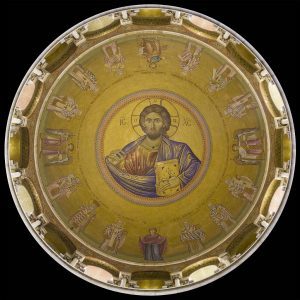 Jerusalem Holy Sepulchre dome CC by AndrewShiva-SA4.0
Jerusalem Holy Sepulchre dome CC by AndrewShiva-SA4.0Today I’m wrapping up my series on “How to Have a Good First Visit to an Orthodox Church.” Six posts, not counting this one. (Click here to start at the beginning.)
If you are a Protestant that probably sounds a bit like overkill. You know newbies don’t need much help when they visit your church.
But worship in an Orthodox church is a really cross-cultural experience. Going through those doors and under the dome feels like traveling to another country — and as a visitor you know you don’t speak the language. You need a Lonely Planet guide, or a Protestant to Orthodox/Orthodox to Protestant Dictionary to find your way around.
My aim in this series has been to give you that guide. I figured if you understood six or so major contrasts between worship in the West and the Orthodox East you would be ready to take in the rest on your own.
Really, though, I’ve barely scratched the surface. (See how little I’ve said about the fine points of theology!) This is just the stuff that smacks you in the face, making the experience so very different.
And it is the experience you should aim for.
Lay aside your need to follow along in a book. Just take it in though all your senses.
On your next visit, and the next, you will hear more of the words, notice more of the visual symbols. You will build understanding bit by bit. But the thing to do at first is just experience it.
Religionfull Christianity?
But if you do take in the experience, even with my six big contrasts in mind, there is one thing you are likely to say about Orthodoxy:
It’s so… religious.
And if you are a Protestant, you probably think that is a problem.
We Protestants have a saying.
Christianity is not a religion …
we like to say,
… It’s a relationship.
We’ve come to assume this so completely that we think it comes straight from the Bible. It doesn’t. It comes from our tendency to distill the faith down to its essence, and then think that everything except that essence should be tossed.
The essence we value is the personal encounter of a Christian with God, the transformation of an ongoing relationship of love and trust with Jesus himself. We value that relationship, that inner immediacy of faith, so much that anything outward, anything “religious,” is a problem.
An amazing variety of things brings out our scathing criticism. Anything from vestments to liturgies to shared spiritual practices has us complaining,
It’s too religious.
If we see something, anything, that smacks of formality or ceremony, we think it is a sign that real faith is gone — or at best faith is in the process of dying. We cry
Empty ritual!
Many of us cannot think of that word “ritual” without the modifier, “empty.”
Your experience of Orthodox worship, even of one Sunday Liturgy, is going to show you a lot of ritual. You’ll see a lot of vestments. You’ll hear a lot of pre-written prayers. In fact the only thing that won’t be scripted will be the sermon and the announcements.
But if you ask them they will tell you: these rituals are not empty. They are full. Full of meaning and full of life.
What Orthodoxy shows you is not a contrast between “religion” and “Christianity.” It is a contrast between the West’s “religionless Christianity” and the East’s “religionfull Christianity.”
Religionless Christianity
We think our opposition to “religion” is something from the roots of our Protestant faith — but Luther, Calvin, and the rest didn’t want to eliminate religion. They wanted to correct it.
They wouldn’t brag that the churches and movement they were part of were “not religious.” They would say it was the “true religion — it was authentic Christianity.
Our opposition to “religion,” in my not-at-all-humble estimation, has at several roots:
First is our emphasis on the preaching and hearing of the Word, which pushed away anything that didn’t have a verbal focus.
Second is our 16th-century opposition to idolatry, which actively removed most visual elements from worship.
Third is the 17th-century English Reformed opposition to the Anglican Book of Common Prayer. At the Westminster Assembly they took careful aim at Anglican priests who lifelessly read the liturgy, and created a new mode of worship. Presbyterian pastors would now structure services according to a Directory for Worship but they would always pray and lead in their own words.
This became the Protestant norm. Heartfelt piety always, please, and not rote performance.
Fourth, and most troublingly, was Dietrich Bonhoeffer, the German Lutheran pastor and theologian who, from a Nazi prison cell, suggested that what was needed in 20th century Europe was “religionless Christianity.” The evocative phrase has been snatched up to give an intellectual authority to the evangelical derision of all things “religious.”
Religion AND Christianity — A Bowl for a Pearl of Great Price
If you take courage and spend even one Sunday morning experiencing an Orthodox Liturgy, try thinking of “religion” in a new way.
 Bowl of Pearls
Bowl of PearlsThink of religion as a kind of bowl to carry something of great value. You need a bowl to carry treasure, maybe a whole lot of slippery pearls. You don’t want to lose them. You want them to be there, intact, so you can give them to your children, or your neighbor.
What the Orthodox have is an excellent bowl. Those rituals, those hymns they’ve been singing for over a thousand years, those vestments with all their symbolic meanings, the icons, the incense, the entrances, the sacraments — they are there to carry something of enormous value.
The religion is there to carry the real Christian faith. And they have carried it, from old to young, parents to children, generation to generation, for two thousand years.
 CC by Biswarup Ganguly 3.0
CC by Biswarup Ganguly 3.0Without “religion,” Protestants can’t carry the treasure safely. You may have noticed that we Protestants, for all of our intense personal relationships with God, have a hard time passing the faith to the next generation. We try to carry the treasure in our personal hands — and like water it slips through.
People keep coming to Christ, and so many churches grow. But in church after church you hear the complaint that the younger generation doesn’t come back. In family after family you find parents longing for their children to come to faith — but they don’t.
What we Protestants lack is a good bowl to carry our treasure in. The treasure of an intimate, life-giving relationship with Christ keeps slipping through our fingers as we try to pass it on.
You might notice how few people raised in Orthodox churches find their way into Protestant pews later in life. The Orthodox faith, which uses a believer’s whole body and soul not only on Sunday morning but in living the faith, has staying power. That bowl which is religion carries the pearl of great price, living faith, into their hearts and minds and wills.
There seem to be far more who are raised Protestant but find themselves converting to Orthodoxy. The wonder, the awe, the mystery laden with the grace of God, draws them. The bowl that carries the treasure from parents to children can also carry it to newcomers.
Sure, it is possible to pick up a nominal version of Orthodox faith, just as you can be a nominal Protestant. But any Protestant who assumes that Orthodox Christians aren’t “real” Christians, that they don’t have an intimate and transforming relationship with God, is simply mistaken. They may talk about their love for Christ differently — but their faith is real and strong.
If you want to step under the dome some Sunday but don’t know where to go, here’s a parish locator that includes all branches of the Eastern Orthodox Church found in North America. Just plug in your zip or postal code and see what comes up.
Once you find one near enough to visit, check the website for times. You may need to call to make sure the Liturgy is in English. And ask for recommendations on what to wear — you’ll want to be a good guest, just as they’ll want to be hospitable hosts.
Then go. Light a candle if you want. Let the experience of worship, ancient, modern, and heavenly, wash over you. Pray and praise; listen and learn; stand and sing. Enjoy!
++++++++++++
This post is the conclusion of a seven-part series. To read from the beginning start here. At the end of each post is a link to the next.
I’d love to send all my new articles, along with other announcements, straight to your inbox. Scroll down to the black box with the orange button to subscribe to my weekly(ash) newsletter and all this will be yours…
The post First Visit to an Orthodox Church (conclusion): Religionless Christianity vs Religionfull Christianity appeared first on Gary Neal Hansen.
July 2, 2018
Monday Meditation: RCL Year B, 14th Sunday in Ordinary Time, Mark 6:1-13

 CC by the McClouds 2.0
CC by the McClouds 2.0This week’s text is one that always makes me smile.
Mark 6:1-13 — Jesus Is Rejected in Nazareth
In Mark 6:1-13, Jesus has come home for a visit, and when he teaches in the synagogue all his old family friends and neighbors are blown away. They just can’t believe that the kid they watched growing up has become so wise and accomplished.
They are more than surprised. They are offended.
It is not an unfamiliar sentiment. In all kinds of groups there is a subtle pressure to not stand out.
I remember one summer job where I worked until the break whistle blew because working was less boring than slacking. But boy did I get flack from the crew for not slacking.
It happens in the church too. I’ve seen a prayer group squashed by a pastor who felt threatened by lay people taking action on their own. I’ve seen thoughtful new worship initiatives squashed by lay people who saw any innovation as a danger.
So the people who knew Jesus best were offended by his wisdom and his power.
How dare Jesus grow up and use the gifts he has been given? How dare he flourish? How dare he stand out from the crowd?
Then comes the funny bit.
Jesus acknowledges that they have rejected him as a prophet. He’s frustrated. Their lack of faith holds him back. Here’s how much:
And he could do no deed of power there, except that he laid his hands on a few sick people and cured them.” (Mark 6:5, NRSV)
Personally I think that’s hilarious. On his worst day in ministry all he could do was miraculously cure some sick people.
That’s actually better than my best day. Just sayin’.
Three Lessons on Faith and Faithful Service
Mark’s Gospel, as I’ve noted before, is often teaching lessons about what faith is, whether the word “faith” comes up in any given story or not.
This passage teaches at least three good lessons on faith and faithfulness.
Lesson 1: Lack of Faith Inhibits Flourishing
My first observation here is that the faith of the crowd, or rather their lack of faith, inhibited Jesus’ effectiveness.
That’s a bit too easy to transfer into one’s own ministerial messiah complex:
The reason I can’t do anything good around here is that the people just don’t believe. They are so critical.
But probably best not to see ourselves in the role of Jesus here. Better to see ourselves in the role of his family friends and neighbors.
We need to welcome him back to the neighborhood—to believe in him, to applaud his wisdom and his acts of power.
Maybe the more we welcome him the more he will be able to do in our communities and in our lives.
Lesson 2: Faithfulness Sometimes Means Leaving
But there is a second lesson here: it is the lesson of what Jesus did in light of being rejected by his peeps.
He moved on.
And he was amazed at their unbelief. Then he went about among the villages teaching.” (Mark 6:6, NRSV)
Sometimes you just need to move on. There is wisdom in not staying the course to the erosion of your spirit and the wasting of your resources.
You could argue that faithfulness is valuable in itself, and you would be right.
But then there is the parable of the talents, where the master expected investment and results. (Matthew 25:14-30)
Or, as in the famous saying attributed (apparently falsely) to W.C. Fields,
If at first you don’t succeed, try, try again. Then quit. No need to be a d***** fool about it.
But on the other hand, moving on and teaching everywhere was Jesus’ calling. He wasn’t called to be the residential rabbi of the Nazareth Synagogue. He had a world to save.
Lesson 3: Faith and Faithfulness Includes Dependence on Others
And this itinerant ministry was exactly what he was teaching his most devoted disciples.
His instructions to the disciples are instructive about the ministry and the life he himself modeled.
He sent them two-by-two. His followers were not to go alone — just as he himself did not go alone. He lived and worked in community, with three close friends, twelve chosen apostles, and seventy (or seventy-two) mostly unnamed missionary leaders.
We would do well, in our individualistic world, to heed this message both for ministry and for life. Christian living is a matter of community, making and building and mending ties of genuine love. It can feel impossible at times, but one must keep attempting to draw close.
The solo Christian life just doesn’t work. Our faith is designed for a shared life, a common discipline.
Ministry, likewise, is not a solo affair. Every solo pastor knows how lonely the work can be. It takes creative effort and risk to be in deep partnership, first within the church with non-pastor leaders, and outside, building teams and communities of shared mission with other pastors.
He sent them poor and dependent. Frustrating as it may be, he did not give them an endowment or a pension.
He sent them out with inadequate resources, forcing them to depend on the welcome and support of those they would serve.
He sent them out with discernment and choice. Tempting as it may be to think that we are utterly bound by this dependence on the generous welcome of those we serve, Jesus gave his followers an escape route. They had to discern whether they were truly welcome and supported or in fact not welcome.
If the verdict was that they were not welcome to stay and serve Jesus, then faithfulness to Jesus meant saying goodbye.
If any place will not welcome you and they refuse to hear you, as you leave, shake off the dust that is on your feet as a testimony against them.” (Mark 6:11 NRSV)
That takes courage, actually.
Lesson 2, Reprise
It also can be rather satisfying.
Long ago in a job unrelated to ministry, a temp job, actually, I had to go door to door to every street-level business in a section of downtown Seattle. My task was to explain a new product from a credit-card company.
One day the next stop was a seedy bar, empty as a desert in the early afternoon. The manager let me start my spiel, but constantly interrupted to berate me. He had some bad history with the company that sent me, and he wanted me to pay for it.
I realized I was wasting my time.
I realized I was being abused.
I was not, in fact, welcome.
I turned to leave. As I reached the door, just before stepping into the sunny outside world, I wiped my feet on his mat.
Ahh…
++++++++++++
I’d love to send my Monday Meditations, along with other new articles and announcements, straight to your inbox. Scroll down to the black box with the orange button to subscribe to my weekly(ish) newsletter and all this will be yours…
The post Monday Meditation: RCL Year B, 14th Sunday in Ordinary Time, Mark 6:1-13 appeared first on Gary Neal Hansen.
June 25, 2018
Monday Meditation: RCL Year B, 13th Sunday in Ordinary Time, Mark 5:21-43
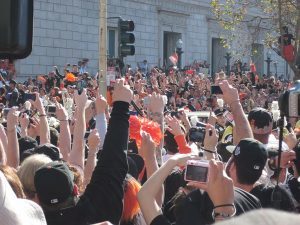
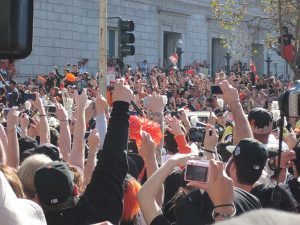 CC by BrokenSphere 3.0
CC by BrokenSphere 3.0The Revised Common Lectionary skips the evocative story of Legion and his many demons, and their demise in a herd of pigs who could not swim, much less fly. (Luke’s version will come up in Year C.)
Instead we skip ahead on the 13th Sunday in Ordinary Time to Mark 5:21-43, another “sandwich passage.” As I said a couple weeks back, that’s my own term for where the Gospel has two related stories to tell. Instead of placing them one after another, the first is split into two (like the bread) and the second is told in the middle (like the BL&T).
Mark 5:21-43
The stories are both about healing. Jairus, the synagogue leader, has a dying daughter, and an unnamed woman has suffered from a bleeding disorder for a dozen years.
But as with so much in Mark, the stories are there to teach us about the nuances of faith — three lessons of increasing difficulty. Along with them we learn about Jesus’ response to faith.
Lesson 1: Faith prompts a really confident request
In the first lesson the word “faith” is not actually mentioned. We see Jairus, faithful leader, member of the social elite, approach Jesus through the crowd. He has an urgent request: Come and lay hands on the sick girl.
But even without hearing the word we see faith in the action. Jairus is confident that his beloved daughter will be well again if Jesus come. Faith is trust. And, trusting, faith asks for help.
We also see the result of faith in Jesus’ response.There is not the slightest hesitation: Jairus asks and Jesus goes.
It isn’t preachy or pushy, this story of faith. But it gives me confidence in prayer — If he came so quickly for Jairus, maybe he’ll come for me as well.
Lesson 2: Faith is attempting to reach Jesus despite all
This poor woman — she suffered in her body for more than a decade.
Bodily suffering was only increased by her attempts to find healing — she spent all her savings on doctors, but nothing helped. She “endured much” from the attempts to cure her, and everything made her worse.
That rings true, as many a cancer patient can tell you. Whether you draw the lot for surgery, radiation, or chemo, sometimes the treatment can feel like a whole ‘nother plague.
And as if bodily suffering were not enough, social stigma followed: ceremonial uncleanliness. What must her life have been like when everybody knew what she was going through, and felt they had to avoid her?
Her faith looks like the opposite of Jairus’. The leader of the synagogue could approach Jesus openly. The bleeding woman had to sneak around.
But she did have the confidence of faith, despite it all. Even more than Jairus, really. She didn’t claim the right to speak to Jesus. She didn’t think Jesus had to come to her home or touch her ailing body — surely she doubted he would do so.
If only she could touch his clothes. That’s all she wanted. That would be enough for Jesus to heal her. That’s faith.
And it didn’t stop there. Think what she went through to reach Jesus. There’s a huge crowd, probably all holding up their phones to get a pic of the savior. How can the woman get through?
Bowed down so her face wouldn’t be seen
Dodging between the people
Zigging left and zagging right
Edging closer and closer
She could hear Jesus’ voice. She knew which one he was. Then a foot away at last, she touched the loose fabric of his tunic.
And it was done.
She knew it. She could sneak away and start her life over.
Jesus knew it too. But he wasn’t content to merely heal her body.
Think of Jesus’ response to this outcast:
He called her out
He looked at her
He spoke to her
He made room for her to tell her story
He called her his daughter
He publicly declared her healed, ending her rejection from the community.
Jesus praised her faith. He also did everything he could to make her whole, body and soul and in society.
So faith pursues Jesus against the odds, and for every possible reason. Because we need healing even if it is refused to us with every possible excuse.
We, the rejected and ashamed and broken, can know and trust that Jesus welcomes, respects, and heals.
And as his Body on earth, we are given his own ministry of welcoming, respecting, and healing our rejected ashamed and broken neighbors.
Lesson 3: Faith has to be nurtured
When Jesus was ready to head on to Jairus’ house, the bad news came: Jairus’ daughter had already died.
This is not a circumstance where the confidence of faith comes easy. For those of us who don’t happen to live in A.D. 30 or so, with Jesus in the flesh walking around among us, the news of a death is final.
But Jairus did happen to live in A.D. 30 or so. And Jesus had agreed to heal his daughter.
Surely Jesus knew how impossible Jairus’ situation seemed. If the leader had not yet collapsed in grief, he would any minute now.
Jesus speaks an impossible word of encouragement:
Do not fear, only believe.” Mark 5:36, NRSV
And of course he’s right. Jesus endures the laughter of those grieving at Jairus’ house because Jesus has already answered Jairus’ faith. He knows what he’s going to do.
And he isn’t going to let any scoffers into the room. His three closest disciples can come. So can Mr. and Mrs. Jairus. I doubt any of them had a great deal of confident faith at that point, but at least they had a vested interest in the project.
Jesus touches the girl, speaks to her, raises her to life.
Then he tells her to go be an ordinary little girl again — have a snack and go play.
What’s the lesson? I suspect the lesson is that Jesus’ faith matters far more than our own. Jesus totally believes in what he is doing. And he does what he can to nurture Jairus’ faith:
Do not fear,
he says,
Only believe.
Easier said than done. But a familiar message: Just like back in the boat in the storm, Jesus wants Jairus to trust, and to let trust displace natural fear.
But whether Jairus really accomplishes that or not, Jesus has decided to heal the girl.
Wondering
I wonder where in my life I’m confident enough to rush up to Jesus and ask for help?
I wonder where in my life I’m so ashamed I need to sneak up to Jesus despite every obstacle?
I wonder who in my world needs to be seen, and welcomed, and lifted to wholeness?
I wonder what in my world Jesus has already decided to do despite the fact that to my human eyes it seems impossible to believe?
++++++++++++
I’d love to send my Monday Meditations, along with my other new articles and announcements, straight to your inbox. Just scroll down to the black box with the orange button to subscribe to my weekly(ish) newsletter and all this will be yours…
The post Monday Meditation: RCL Year B, 13th Sunday in Ordinary Time, Mark 5:21-43 appeared first on Gary Neal Hansen.



